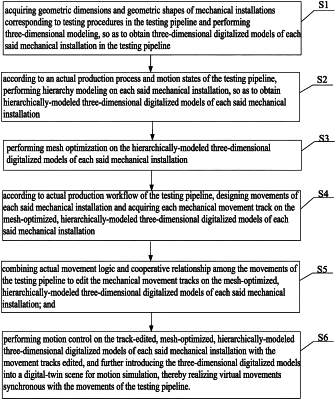| CPC G06F 30/20 (2020.01) [G01R 31/3277 (2013.01); G05B 17/00 (2013.01); G05B 19/41885 (2013.01)] | 6 Claims |

|
1. A digital-twin modeling method for an automated testing pipeline for circuit breakers, comprising steps of:
Step S1, acquiring geometric dimensions and geometric shapes of mechanical installations corresponding to testing procedures in the testing pipeline and performing three-dimensional modeling, so as to obtain three-dimensional digitalized models of each said mechanical installation in the testing pipeline;
Step S2, according to an actual production process and motion states of the testing pipeline, performing hierarchy modeling on each said mechanical installation, so as to obtain hierarchically-modeled three-dimensional digitalized models of each said mechanical installation;
Step S3, performing mesh optimization on the hierarchically-modeled three-dimensional digitalized models of each said mechanical installation;
Step S4, according to actual production workflow of the testing pipeline, designing movements of each said mechanical installation and acquiring each mechanical movement track on the mesh-optimized, hierarchically-modeled three-dimensional digitalized models of each said mechanical installation;
Step S5, combining actual movement logic and cooperative relationship among the movements of the testing pipeline to edit the mechanical movement tracks on the mesh-optimized, hierarchically-modeled three-dimensional digitalized models of each said mechanical installation; and
Step S6, performing motion control on the track-edited, mesh-optimized, hierarchically-modeled three-dimensional digitalized models of each said mechanical installation with the movement tracks edited, and further introducing the three-dimensional digitalized models into a digital-twin scene for motion simulation, thereby realizing virtual movements synchronous with the movements of the testing pipeline;
wherein “according to actual production workflow of the testing pipeline, designing movements of each said mechanical installation and acquiring each mechanical movement track on the mesh-optimized, hierarchically-modeled three-dimensional digitalized models of said mechanical installation” in Step S4 comprises steps of:
dividing motions of each said mechanical installation in the actual production workflow into a plurality of movement track sections;
determining a chronological order of the plural movement track sections of each said mechanical installation;
according to the chronological order of the plural movement track sections of each said mechanical installation, on the mesh-optimized, hierarchically-modeled three-dimensional digitalized models of each said mechanical installation, determining the highest level model of each said movement track section of each said mechanical installation, and recording an initial position and an end position of the highest level model of each said movement track section of each said mechanical installation; and
taking the recorded initial and end positions of the highest level model of each said movement track section of each said mechanical installation as key frames, and combining all the recorded key frames of the same mechanical installation according to the chronological order of the corresponding movement track sections, so as to obtain the mechanical movement tracks on the three-dimensional digitalized models of each said mechanical installation.
|